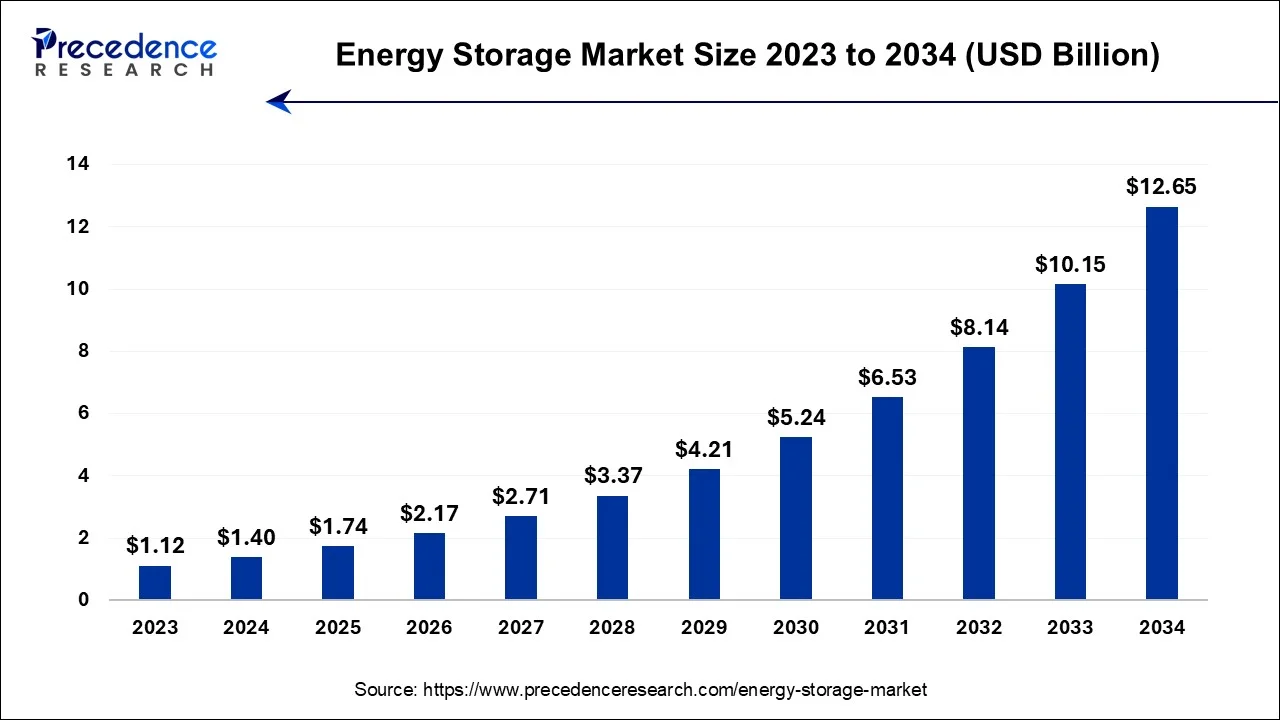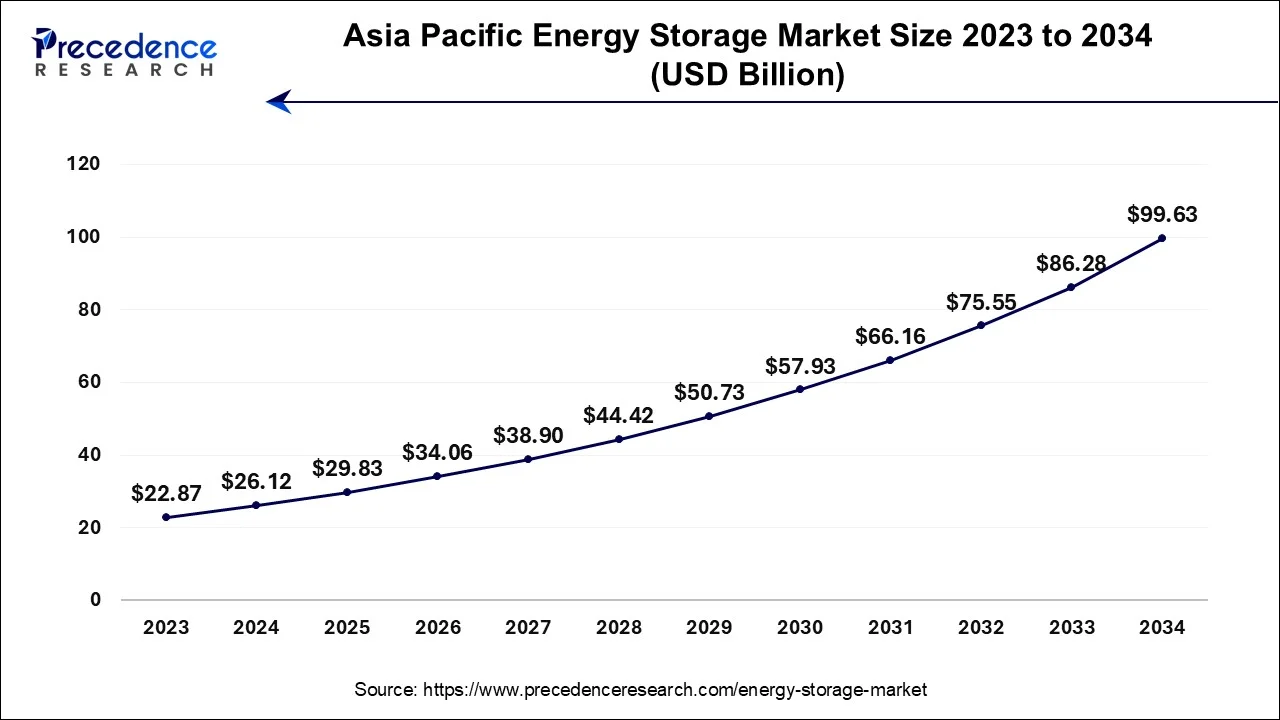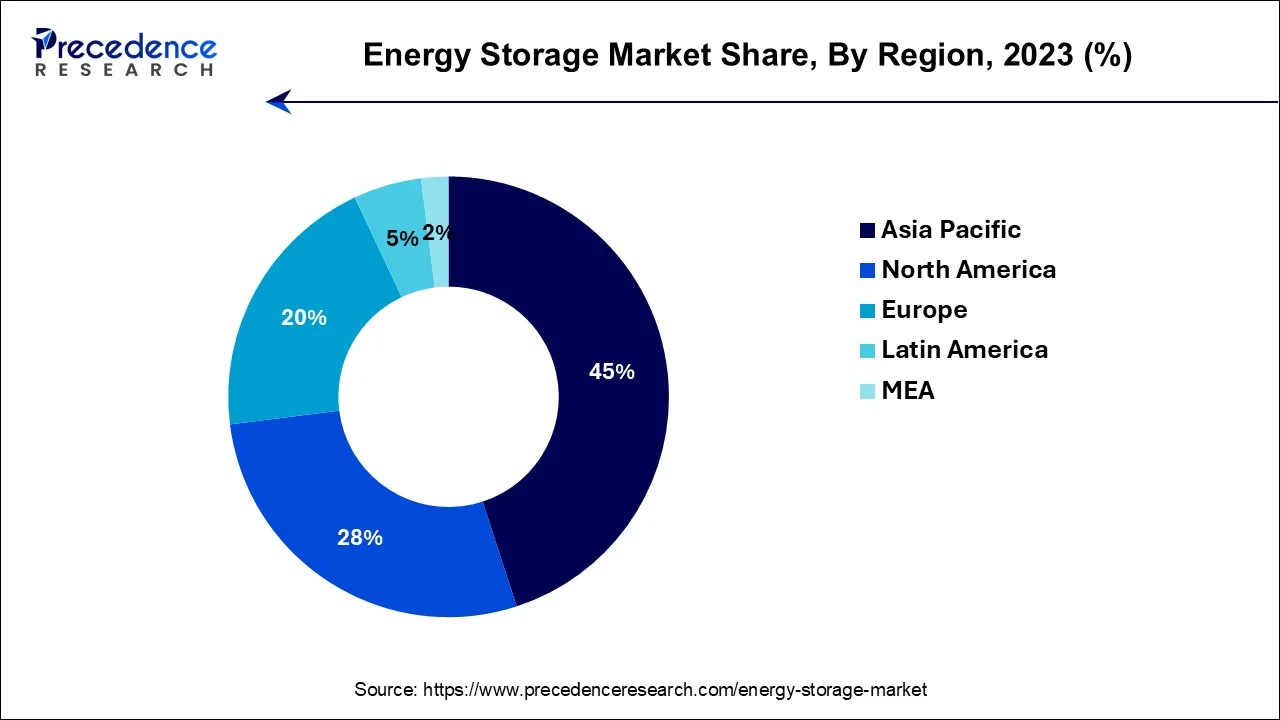What is the Energy Storage Market Size?
The global energy storage market size accounted for USD 1.74 billion in 2025 and is anticipated to to reach around USD 12.95 billion by 2034, expanding at a CAGR of 14.20% between 2025 and 2034.

Market Highlights
- Asia Pacific contributed more than 45% of revenue share in 2024.
- North America is estimated to expand the fastest CAGR between 2025 and 2034.
- By Type, the pumped-storage hydroelectricity (psh) segment has held the largest market share of 35% in 2024.
- By Type, the others segment is anticipated to grow at a remarkable CAGR of 15.1% between 2025 and 2034.
- By Application, the commercial and industrial segment generated over 56% of revenue share in 2024.
- By Application, the residential segment is expected to expand at the fastest CAGR over the projected period.
Market Size and Forecast
- Market Size in 2025: USD 1.74 Billion
- Market Size in 2026: USD 2.17 Billion
- Forecasted Market Size by 2034: USD 12.65 Billion
- CAGR (2025-2034): 14.20%
- Largest Market in 2024: North America
- Fastest Growing Market: Asia Pacific
MarketOverview
Energy storage encompasses the art of accumulating and safeguarding energy in diverse guises to harness at a later time. It serves as a pivotal element within contemporary energy frameworks, facilitating equilibrium between the availability and necessity of energy. This encompasses conventional methodologies like electric storage via batteries and the ingenious mechanism of pumped hydro storage, where energy is preserved by elevating water to be discharged subsequently. Energy storage proves instrumental in bestowing consistency torenewable energyresources, such as wind and solar, by amassing excess energy when it abounds and disbursing it during periods of heightened demand. This innovation stands as a linchpin for bolstering grid reliability, mitigating energy expenses, and fostering a sustainable energy landscape.
Energy Storage Market Growth Factors
- The energy storage market experiences substantial impetus from its role in harmonizing renewable energy sources. The variability of solar and wind power necessitates storage solutions, as excess energy can be stored during surpluses and discharged during shortages. This facilitates the transition to eco-friendly energy, aligning with global sustainability efforts.
- The growing necessity for grid reliability and resilience, especially in the face of surging energy demand and extreme climate events, acts as a major catalyst. Energy storage systems balance power supply and demand, avert blackouts, and offer a lifeline during outages, strengthening grid robustness and dependability.
- The electric vehicle (EV) revolution significantly contributes to the burgeoning energy storage sector. Lithium-ion batteries, the driving force behind EVs, experience soaring demand. This EV market expansion necessitates battery innovation, enhancing the efficiency and affordability of energy storage solutions across various domains.
- Escalating energy costs drive businesses and consumers to adopt energy storage. Storing energy during off-peak hours and deploying it during peak periods offers substantial cost savings, especially for high-energy consumers and commercial entities. It is also appealing to households, augmenting the affordability and sustainability of energy.
- In remote and off-grid regions, energy storage plays a pivotal role in expanding power access. Microgrids integrated with energy storage ensure a consistent electricity supply, driven by the need for reliable power and the demand for clean energy sources in underserved areas.
- The ceaseless innovation in energy storage technology remains a primary growth driver. Ongoing research and development enhance battery efficiency, longevity, and sustainability. Emerging technologies like solid-state and flow batteries present viable alternatives to conventional solutions, spurring versatility and affordability.
- Government incentives and policies incentivize energy storage adoption. Financial incentives, tax benefits, and regulatory support promote energy storage integration with renewables, reducing initial investment barriers and elevating overall returns.
- The deregulation of electricity markets encourages competition and market innovation. Energy storage enables users to capitalize on price fluctuations, facilitating optimal power purchase decisions, and aligning with the consumer empowerment trend.
Market Scope
| Report Coverage | Details |
| Market Size in 2025 | USD 1.74 Billion |
| Market Size in 2026 | USD 2.17 Billion |
| Market Size by 2034 | USD 12.65 Billion |
| Growth Rate from 2025 to 2034 | CAGR of 14.20% |
| Largest Market | Asia Pacific |
| Base Year | 2025 |
| Forecast Period | 2025 to 2034 |
| Segments Covered | Type, Application, and Region |
| Regions Covered | North America, Europe, Asia-Pacific, Latin America, Middle East & Africa |
Market Dynamics
Drivers
Grid stability and resilience
The energy storage market experiences a surge in growth driven by the imperatives of grid stability and resilience. In an era of escalating complexity and grid susceptibilities, energy storage stands out as a pivotal solution. Today's grids grapple with a confluence of challenges, including erratic renewable energy supplies, escalating energy demands, and the capriciousness of extreme weather conditions.
Energy storage systems assume a role of paramount significance by adeptly amassing surplus energy during periods of subdued demand and orchestrating its release during surges, effectively counteracting power interruptions and diminishing the vagaries of grid irregularities. Furthermore, grid resilience stands as a powerful motivator. Energy storage engenders an alternative power source during grid upheavals, whether they stem from malevolent cyber intrusions, natural calamities, or equipment malfunctions.
The capacity to respond promptly to disruptions becomes the linchpin for various industries, safeguarding critical infrastructure, and buttressing the preparedness of emergency services. It concurrently curtails the grid's overall susceptibility, bestowing it with a heightened level of robustness in the face of unforeseen challenges. In these roles as facilitator of grid stability and enabler of grid resilience, energy storage ascends as an indispensable cornerstone in contemporary energy systems. This dual attribute garners substantial investments and catalyzes the expansion of the energy storage market, as grid reliability takes center stage in an ever-evolving energy landscape.
Restraint
Limited energy density
Constrained energy density stands out as a significant constraint impeding the expansion of the energy storage market. Energy storage technologies, particularly batteries, grapple with intrinsic limitations concerning how much energy they can house relative to their physical dimensions and weight. These boundaries imply that for applications demanding substantial energy reserves, like extended-range electric vehicles or large-scale grid storage, the spatial and weight requisites for achieving the necessary energy capacity become burdensome and unfeasible.
Such limitations not only erode the efficiency and efficacy of energy storage solutions but also introduce challenges related to mobility and spatial allocation. Frequently, the necessity for larger installations or heavier batteries amplifies costs and undermines the overall viability of energy storage ventures. Surmounting these constraints mandates advancements in materials science and engineering to cultivate storage solutions characterized by superior energy density, an arena continually explored for innovation within the energy storage realm.
Opportunity
Electric vehicle (EV) market
The burgeoning electric vehicle (EV) market acts as a fulcrum for substantial prospects within the energy storage domain. EVs, hinging on high-capacity batteries for their locomotion, are not only a driving force but also a crucible of technological innovation and scale economies in energy storage. The surging demand for EVs catalyzes extensive research and development, culminating in the emergence of more efficient and cost-efficient battery technologies. These breakthroughs, originally intended for the EV sector, radiate into diverse applications across the energy storage landscape.
Additionally, the proliferation of EV charging infrastructure and the advent of bi-directional vehicle-to-grid (V2G) systems enable an intricate exchange of energy between EVs and the grid. This paves the way for leveraging EV batteries as grid storage reservoirs, buttressing grid reliability, and fortifying the assimilation of renewable energy resources. The EV market, with its transformative influence on battery technology and grid interplay, emerges as a dynamic force propelling the expansion and diversification of the energy storage market.
Segments Insights
Type Insights
According to the type, the pumped-storage hydroelectricity (psh) has held a 35% revenue share in 2024. Pumped-storage hydroelectricity (PSH) commands a significant share in the energy storage market due to its unique ability to store and release large amounts of energy swiftly and efficiently. PSH systems use surplus electricity to pump water uphill, storing potential energy, which can be rapidly converted back into electricity when demand surges. This quick response and high energy capacity make PSH ideal for grid stability, especially in managing fluctuations from intermittent renewable sources. Its proven track record, reliability, and ability to support the integration of renewables have solidified PSH as a major player in the energy storage landscape.
The others segment is anticipated to expand at a significant CAGR of 15.2% during the projected period. The others segment in the energy storage market holds a significant share due to its diversity of technologies and applications. It encompasses emerging and specialized energy storage solutions, such as flywheels, compressed air energy storage, and thermal storage. These systems cater to a wide range of unique needs, from short-duration grid stabilization to long-term energy storage for industrial processes. Moreover, as innovation continues, this segment is particularly dynamic, offering versatile and customized solutions for specific use cases, thereby contributing substantially to the overall energy storage market's adaptability and growth.
Application Insights
Based on the application, the commercial and industrial segment is anticipated to hold the largest market share of 56% in 2024. Commercial entities seek to reduce energy costs and enhance energy reliability, while industries aim to manage demand and integrate renewable sources. Energy storage solutions offer grid stability, peak shaving, and backup power during outages, aligning with C&I objectives. Moreover, incentives, including demand charge management and energy arbitrage, drive adoption in this segment. As C&I users increasingly embrace sustainability and self-generation, energy storage plays a pivotal role in meeting these goals, securing its major market share.
On the other hand, the others segment is projected to grow at the fastest rate over the projected period. The residential sector commands a substantial share of the energy storage market for various compelling reasons. One pivotal factor is the growing prevalence of residential solar installations, prompting homeowners to seek energy storage options to capture surplus energy for later use. Moreover, heightened environmental awareness encourages households to reduce their grid dependence and embrace cleaner energy sources. The quest for energy self-sufficiency and the potential for economic advantages further propel residential interest in energy storage solutions. This confluence of motivations establishes the residential segment as a prominent driver in propelling the energy storage market forward.
Regional Insights
Asia Pacific Energy Storage Market Size and Growth 2025 to 2034
The Asia Pacific energy storage market size is estimated at USD 29.83 billion in 2025 and is expected to be worth around USD 99.63 billion by 2034, registering a CAGR of 14.32% from 2025 to 2034.

Asia Pacific has held the largest revenue share 45% in 2024. The Asia-Pacific region has carved out a prominent niche in the energy storage market due to a convergence of distinctive factors. Primarily, its meteoric economic expansion and urbanization, most notably in countries such as China, Japan, and South Korea, have spurred a heightened appetite for energy, catalyzing the adoption of energy storage solutions. Concurrently, robust governmental initiatives, encompassing financial incentives and ambitiousrenewable energy integration targets, have propelled the rapid development of energy storage projects. The region's burgeoning electric vehicle market, combined with an ardent drive for grid modernization and energy security, has further stoked the fervor for energy storage technologies, cementing its commanding presence in the market.

North America is estimated to observe the fastest expansion. North America commands a significant share of the energy storage market for various reasons. First, the region has witnessed robust investments in renewable energy projects, requiring energy storage to manage intermittent sources. Additionally, supportive government policies, tax incentives, and a strong regulatory framework have stimulated market growth. North America's growing electric vehicle market has also fueled the demand for advanced energy storage solutions. Moreover, the need for grid stability and resilience in the face of extreme weather events further drives the adoption of energy storage. These factors collectively establish North America as a major player in the energy storage market.
Why Did Europe Consider a Notable Region in the Energy Storage Market?
Europe is anticipated to experience significant growth soon, particularly as it transitions to renewable energy sources. Ambitious climate goals and supportive policies primarily drive this growth. The continent is seeing substantial increases in energy storage capacity, focusing on both grid-scale and distributed systems. Europe is heavily investing in renewable energy sources such as solar and wind, which are intermittent and require energy storage solutions to balance fluctuations in supply and demand. As a result, large-scale energy storage is essential to support the transition to a low-carbon energy system. Additionally, Europe's energy storage market features a diverse range of technologies, including lithium-ion batteries, pumped hydro storage, and emerging solutions like flow batteries and hydrogen storage.
How Will Latin America Impact the Energy Storage Market?
Latin America is also emerging as a significant player in the global energy storage market, driven by an increasing adoption of renewable energy, rising electricity demand, and a greater emphasis on grid stability. Many countries in the region have aging electricity grids that need upgrades and modernization to meet the growing electricity demand and to effectively integrate renewable energy sources. Energy storage technologies are vital for enhancing grid stability and flexibility. The region's abundant renewable energy resources, particularly solar and wind, combined with the need to modernize outdated grids, are creating a strong demand for energy storage solutions.
How Will the Middle East and Africa Emerge in the Energy Storage Market?
The Middle East and Africa are experiencing rapid growth in the energy storage market, primarily due to the increasing adoption of renewable energy, a push for energy security, and government initiatives that promote clean energy. Many countries in this region are focused on diversifying their energy mix and reducing their reliance on traditional fossil fuels, making energy storage crucial for maintaining grid stability and reliability. The abundance of solar and wind resources, along with government targets for decreasing fossil fuel dependency, is creating significant opportunities for energy storage technologies in the region.
Energy Storage Market Companies
- Tesla
- LG Chem
- BYD
- Panasonic
- AES Energy Storage
- Fluence
- Siemens
- ABB
- Saft
- ESS Inc.
- NEC Energy Solutions
- Samsung SDI
- Sunrun
- Green Charge
- Enel X
Future Demand for Energy Storage Market
Future demand for energy storage systems will dramatically increase due to the inevitable growth of renewable sources of energy that are intermittent, like solar and wind. Studies show that demand drivers include the need to manage peak load, ensure grid stability, and the importance of decentralized energy. Additionally, policy drivers and net-zero commitments across major economies support a more permanent long-term increase in market activity and demand, particularly in electric mobility and residential and utility-scale applications.
Leaders Announcements
- In April 2025, Sunwoda Energy launched the Sunwoda MESS 2000, the world's first 10-metre-class mobile energy storage system vehicle with a 2 MWh energy storage capacity. Sunwoda's MESS 2000 mobile energy storage vehicle redefines the role of mobile power, evolving from a tool for emergencies to a key player in everyday energy supply. (Source: https://www.pv-magazine.com)
- In March 2025, Atlas Copco launched a 1 MW battery energy storage system, the ZBC 1000-1200, which delivers 1 MW of power from a single unit. The new ZBC 1 MW is built using the same advanced battery technology as Atlas Copco's existing range of ESS to deliver a reliable source of power and enable users to reduce emissions by up to 90% while saving on costs. (Source: https://im-mining.com)
- In February 2025, Global energy storage owner-operator BW ESS and Munich-based energy storage developer MIRAI Power partnered, setting out plans to co-develop up to 1GW of energy storage projects in Southern Germany. With BW ESS' experience of rapidly scaling energy storage pipelines across a range of other global markets, as well as its proven supply chain and investment connections, the partners will jointly originate and develop opportunities in the South of the country. (Source: https://bw-group.com)
- In September 2024, an intelligent power management company, Eaton, announced a planned collaboration with Tesla designed to boost the functionality and adoption of home energy storage and solar installations in North America. "This collaboration will enhance what's possible within the home energy ecosystem, allowing our customers to get even more value from their Powerwall and Solar and furthering our mission to accelerate the world's transition to sustainable energy," said James Bickford, Director of Global Sales, Residential Energy Products at Tesla. (Source: https://www.businesswire.com)
Recent Developments
- In February 2022,FIMER and Vega Solar joined forces to provide 14 PVS-100 inverters, a three-phase string solution, to Albania. The PVS-100/120-TL, designed by FIMER, is a cloud-connected three-phase string inverter tailored for cost-effective decentralized solar systems, whether on the ground or on rooftops.
- In May 2022,Salient Energy unveiled a significant partnership with Horton World Solutions (HWS). Salient Energy is known for pioneering proprietary zinc-ion batteries as an alternative to lithium-ion batteries for residential energy storage. On the other hand, HWS is a sustainable homebuilder renowned for its unique composite framing system, which not only enhances energy efficiency but also accelerates construction timelines. This collaboration signals a promising synergy between energy storage innovation and sustainable construction methods.
Segments Covered in the Report
By Type
- Batteries
- Pumped-storage Hydroelectricity (PSH)
- Thermal Energy Storage (TES)
- Flywheel Energy Storage (FES)
- Other Types
By Application
- Residential
- Commercial and Industrial
- Distribution
- Transmission
- Other
By Region
- North America
- Europe
- Asia-Pacific
- Latin America
- Middle East and Africa
For inquiries regarding discounts, bulk purchases, or customization requests, please contact us at sales@precedenceresearch.com
Frequently Asked Questions
Ask For Sample
No cookie-cutter, only authentic analysis – take the 1st step to become a Precedence Research client
 sales@precedenceresearch.com
sales@precedenceresearch.com
 +1 804-441-9344
+1 804-441-9344